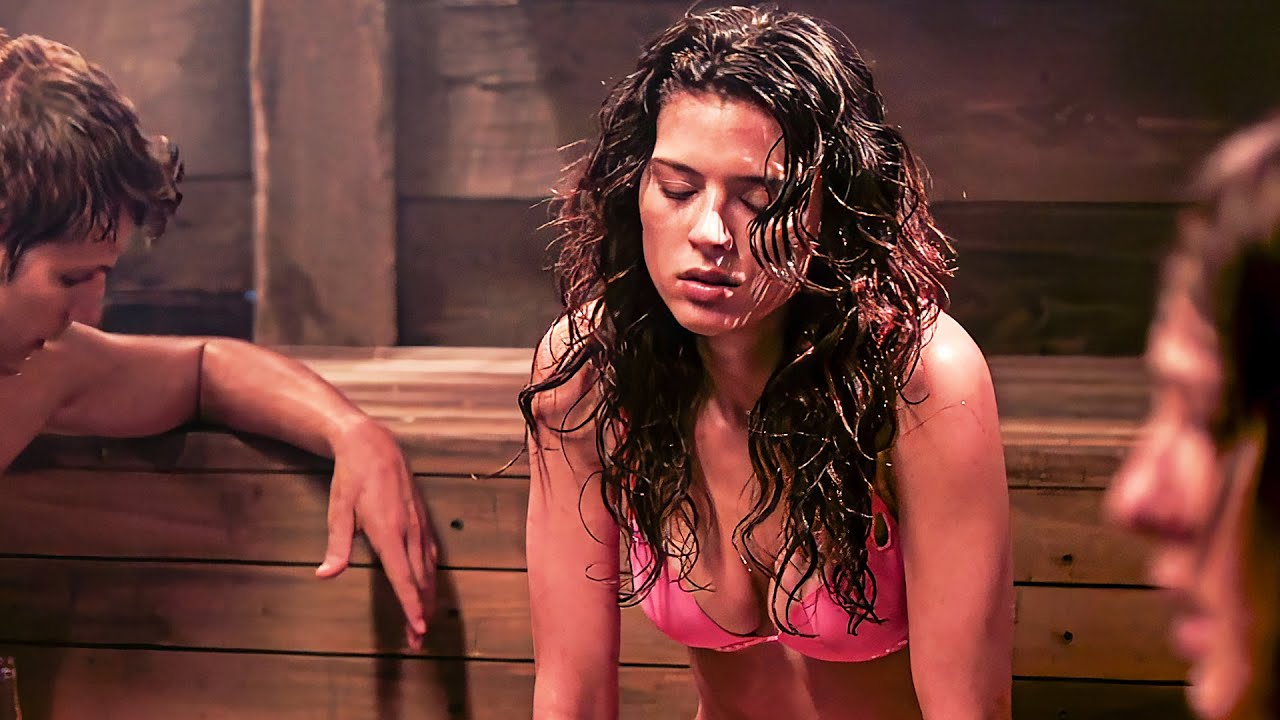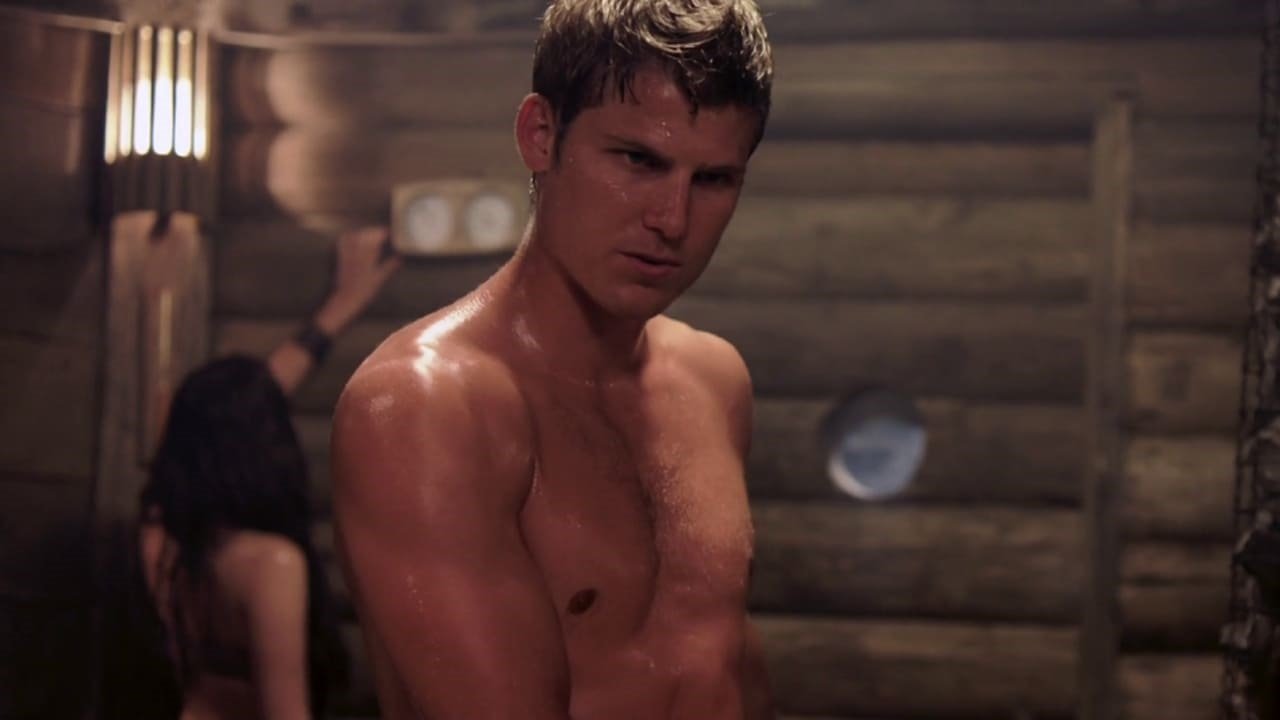247°F (2011): A Slow Burn in a Sauna of Terror
247°F is a tense, low-budget survival thriller directed by Levan Bakhia and Beqa Jguburia. Rooted in a terrifyingly simple concept, it draws inspiration from real-life accidents involving saunas. The film asks one chilling question: What would happen if you were locked inside a heat chamber with no way out?
The story follows Jenna (Scout Taylor-Compton), a young woman struggling to rebuild her life after losing her fiancé in a tragic car crash. Her friend Renee (Christina Ulloa) invites her to a lakeside cabin for a relaxing weekend escape. Renee’s boyfriend Michael (Michael Copon) and his friend Ian (Travis Van Winkle) join them. On the surface, the trip is about fun, relaxation, and possibly healing—especially for Jenna, who remains emotionally distant due to her past trauma.
The central turning point occurs when the group uses the cabin’s sauna. After a night of drinking and socializing, Jenna, Renee, and Ian decide to sweat out their hangovers. The sauna door, old and unreliable, becomes their trap. At first, it's just mildly frustrating—then disturbing. They realize that the door is jammed from the outside. Worse yet, the sauna’s temperature control malfunctions after the small safety window is broken, sending the heat climbing steadily toward deadly levels.

The title 247°F refers to the approximate temperature at which water boils in an enclosed space—far beyond what the human body can endure. As the temperature rises, so does the tension. Oxygen thins, sweat pours, and the trio spirals from calm logic into rising hysteria. Ian tries to act as the problem-solver, but each attempt to escape or break the system backfires. Jenna, already haunted by loss, clings to the hope that someone will come. Renee grows weaker by the hour.
Unbeknownst to them, Michael, who drunkenly left the sauna earlier, remains clueless about what’s happening. He spends most of the night away from the cabin, delaying any chance of rescue. The audience, now privy to the real-time unfolding of both inside and outside events, is left gripping their seat in frustration. Every minute that ticks by inside the sauna feels like a punch to the gut.
The narrative is contained almost entirely within the small space of the sauna, which becomes a psychological crucible. Cinematographer cinematography uses close-ups, sweat-slicked skin, and limited lighting to emphasize the oppressive environment. As the steam clouds vision and muffles sound, viewers share in the characters’ sense of disorientation and claustrophobia. It’s a story of slow, relentless pressure, both physical and emotional.

Each character reacts differently under the heat and stress. Ian tries to hold it together but eventually panics. Renee deteriorates quickly, her physical weakness mirroring her emotional unraveling. Jenna, initially the most withdrawn and fragile, emerges as the one most capable of holding on—perhaps because she’s already survived emotional trauma and knows what endurance feels like.
The film’s most intense moment comes when Ian, in a desperate attempt to disable the heater, causes an electrical short that results in his death. His demise is not heroic but chaotic—emphasizing how quickly rational thought can give way to fatal mistakes under pressure. Jenna and Renee are now alone, near collapse, fighting for survival with no tools, no strength, and little hope.
Meanwhile, the outside world continues blissfully unaware. Michael, upon returning, assumes the others are off enjoying themselves. The true horror of 247°F lies not just in the unbearable temperature but in the silence from the outside—no one hears, no one helps, no one realizes.
Eventually, Wade, Ian’s uncle and the property owner, returns to the cabin and discovers what’s happening. In a race against time, he smashes into the sauna and rescues the women, who are moments from death. The rescue is abrupt and harrowing—a literal blast of cold air and light into a scene defined by suffocation.

The film ends without unnecessary sentimentality. Jenna and Renee are pulled out, limp and delirious. There’s no grand speech or melodramatic closure. Their survival is raw, unresolved, and real. Michael’s stunned face offers no redemption. We’re left to imagine the aftermath: trauma, recovery, guilt.
247°F isn’t a flashy horror film. It doesn’t rely on gore, monsters, or elaborate plot twists. Its strength lies in its minimalism—a single location, four characters, and one escalating danger. That simplicity makes it both effective and divisive. Some viewers find it slow or overly restrained, wishing for more plot development or backstory. Others appreciate its restraint and realism, noting that it captures a plausible and truly terrifying scenario.
Thematically, the film explores helplessness, the breakdown of control, and survival instinct. Jenna’s arc—emerging from trauma into another life-threatening experience—provides a subtle layer of emotional depth. The sauna becomes not just a physical prison, but a metaphor for her internal state: sealed shut, steaming with past grief, and demanding endurance before escape.

The performances vary in quality. Scout Taylor-Compton does a fine job portraying Jenna’s quiet resilience. Travis Van Winkle brings energy to Ian, though his character is more reactive than layered. Christina Ulloa’s Renee is believable but underwritten. Michael Copon’s character is frustratingly passive, which, while realistic, limits audience sympathy. The film isn’t about complex character development—it’s about the moment pressure rises and choices are made.
Despite mixed reviews, 247°F succeeds in what it sets out to do: trap the audience in a boiling room with no clear way out and force them to feel the dread inch by inch. It’s a survival story, not just in plot but in tone—gritty, tense, and deliberately uncomfortable.

-1751100889-q80.webp)

-1751508693-q80.webp)